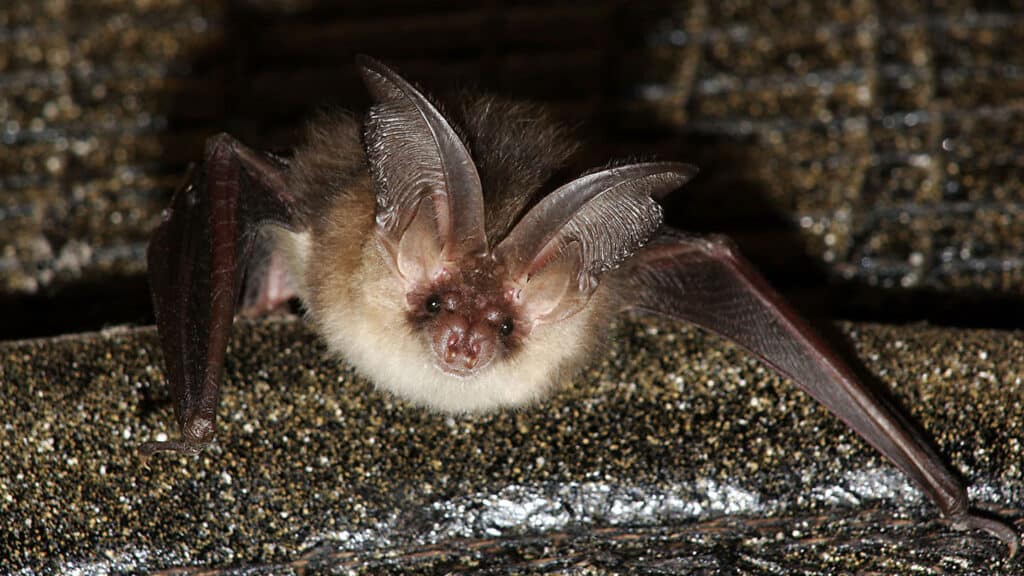In the mysterious realm of nocturnal creatures, the brown long-eared bat (Plecotus auritus) emerges as a captivating and enigmatic species, drawing the attention of researchers and nature enthusiasts alike. With its distinct characteristics and fascinating behaviours, this bat species has woven itself intricately into the natural fabric of our world.
Adapting to the Night
The brown long-eared bat is a creature of the twilight, gracefully adorned with velvety brown fur and strikingly elongated ears, from which it derives its name. These ears serve a vital purpose, enhancing the bat’s auditory capabilities and enabling it to detect even the faintest rustle of prey. As the sun dips below the horizon, these bats take flight, navigating the darkness with unparalleled agility and skill.
Wings of Grace

The elegant wingspan of the brown long-eared bat is a testament to its mastery of flight. Equipped with a delicate membrane, these wings allow the bat to effortlessly glide through the night sky. This aerial prowess is not only essential for hunting but also for evading predators and traversing the intricate landscapes of their habitats.
Navigating with Precision
Echolocation, often referred to as nature’s GPS, is a remarkable phenomenon that defines the brown long-eared bat’s navigation system. Emitting high-frequency calls, these bats create a sensory map of their surroundings based on the echoes that bounce back. This intricate mental map helps them to avoid obstacles, locate prey, and maintain a keen sense of spatial awareness, even in complete darkness.
Exploring the Diet
The brown long-eared bat’s diet is a fascinating aspect of its biology. These agile creatures embark on nocturnal forays in search of sustenance, primarily preying upon moths, beetles, and a variety of insects that thrive during the night. Their culinary preferences not only satiate their hunger but also play a crucial role in maintaining the balance of ecosystems.
Culinary Preferences
The brown long-eared bat’s culinary choices are a reflection of its adaptive strategy. Moths, with their erratic flight patterns and large size, are a favoured target due to the energy-rich content they provide. The bat’s adept hunting skills allow it to intercept these airborne delicacies with remarkable precision, showcasing the synergy between their echolocation prowess and hunting tactics.
Ecological Significance
Beyond their innate beauty, the dietary habits of brown long-eared bats hold immense ecological significance. By preying on nocturnal insects, these bats serve as natural pest controllers, regulating insect populations and minimising the need for chemical pesticides. This symbiotic relationship with the environment underscores the delicate balance that exists within ecosystems.
The Art of Roosting
Throughout the daylight hours, brown long-eared bats find solace in their roosts, which are often nestled in crevices, caves, and old structures. These safe havens serve as a sanctuary for rest, grooming, and conserving energy for the night’s endeavours. The choice of roosting sites is critical for their survival, offering protection from predators and adverse weather conditions.
Social Bonds and Colony Life
Brown long-eared bats are not solitary creatures; they thrive in colonies that foster social bonds crucial for their existence. These colonies provide avenues for interaction, communication, and sharing of vital information. The bats engage in grooming sessions and even share food, contributing to a sense of community among these fascinating creatures.
Conservation Efforts and Challenges
Despite their adaptive prowess, brown long-eared bats face challenges that threaten their survival. Human activities, including habitat destruction and indiscriminate pesticide use, have led to a decline in their populations. Conservationists work tirelessly to raise awareness and implement measures to protect their habitats, advocating for sustainable practices and habitat restoration.
Shaping the Future Together
The future of brown long-eared bats depends on collective efforts to preserve their habitats and mitigate the threats they face. Conservation initiatives involve creating suitable roosting spaces, preserving natural habitats, and promoting the responsible use of pesticides. By working in harmony with nature, we can ensure the continued thriving of these remarkable creatures.
Conclusion
In the tapestry of life, the brown long-eared bat adds a thread of intrigue and wonder. Its adaptation to the night, intricate navigation skills, and social dynamics offer a glimpse into the complex world of nocturnal creatures. As we strive to protect and understand these enigmatic beings, we deepen our connection with the delicate web of life that unites us all.
Sam loves to learn about animals and their habitats. He has been a nature lover from a very young age, and has been writing papers and articles about wildlife for as long as he can remember.
